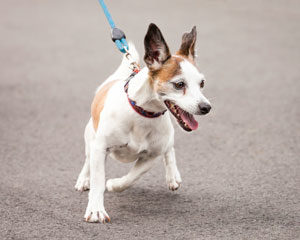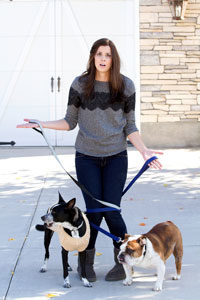Walk This Way
How to train your dog to behave properly when on a leash.

I believe you can train any type of animal with positive reinforcement. For this reason, I recommend you avoid choke collars, prong or pinch collars and electronic or static correction collars. If you feel that you cannot train your dog without using one of the aforementioned collars, then it’s time to call in a professional trainer for assistance.
One of the most important skills you can teach a dog is training her to walk on a leash. Proper leash etiquette helps ensure that should anything happen to you; your pet will more easily be adopted and treated well in a new home. Beyond that “worst case” scenario, it’s important for your own sanity to have a well-behaved dog on leash.
Find the Proper Motivation
First, it’s important to find your dog’s most valued incentive for performing. You can try a variety of things from treats to toys. Every dog has an item she can’t do without. For some dogs, that’s a ball or favorite toy. For others, it’s a “high-value” treat. Once you find your dog’s greatest source of motivation, you can begin training.
Tire Your Dog Out
If you have a high-energy, easily-excitable dog, it’s important to get her good and tired prior to beginning training. You might want to play a game of fetch or just let her run in the yard for an hour. Once your dog is tired, she will be much more receptive to training.
The Process
There are many different schools of thought on training, but This is the way I prefer:
- Begin each training session with your dog’s “motivation” in an easily accessible pocket. It’s traditional to keep your dog on your left, but you can choose the side that is most comfortable for you and your dog.
- Start by attaching your dog to a leash that is 6- to 10-ft long (but not retractable) while hse is wearing a standard collar (avoid choke and prong collars).
- Begin your practice in an enclosed area (such as a fenced yard). You’ll want to reward your dog as she walk, so keep your treats handy.
- Walk forward at a brisk pace, keeping your dog at your side. Each time she is doing something exactly as you wish, reward her with a treat. If she tends to lie down or stop while eating, you might want to consider an alternate form of reward (such as a ball).
- Walk at a quick pace. This will help minimize distractions and keep your dog focused on you.
As you build up confidence, you can increase the walking times. As you practice, your dog will become more focused and less distracted.
Start Slowly
Work in short bursts in order to keep your dog’s attention. For instance, you might put the leash and collar on your dog, condition her to wait quietly at door with you, then walk outside to end of driveway and return. Keep in mind that dogs have short attention spans and it’s better to do something right than practice something that is wrong.
Many people run into specific problem when training. Here are the solutions I use to solve a few of them.
Problem: Dog Pulls on Leash

- Use treats as an incentive to keep her head close to your hand. Enclose treats (or other high-value rewards) in your hand, then randomly distribute as you walk.
- Consider an alternate form of control, such as an EZ-lead, Walk-In Sync Harness
- Give your dog a “job.” This might include wearing a backpack (do not replace leash on collar or harness, merely add to the setup). This causes your dog to concentrate on walking and carrying something instead of the duck that just walked in front of her.
- Hold leash, turn, then walk at a normal speed in the other direction. When doing this, be sure you’re not “yanking” on your dog’s head. When your dog is in position beside you again, be quick with a treat to reward her.
Problem: Dog Refuses to Move
- Use high-value treats to coax her on.
- If you have a small dog, consider using a harness that allows you to pick the dog up and move her gently along, doing so often stimulates movement

Problem: Dog Tangles Leash
- Lure her into the correct position beside you with a treat, while grasping the leash midway down to shorten its length (keep the leash handle looped over your hand when you do this).
- Mark the position with a cue word and reward. As you take a few steps forward, slowly release the leash by moving your hand up it a little bit at a time.
- Give the cue word to remind your dog to resume position.
- Repeat until she stays beside you, slowly releasing the shorter leash and increasing the time between treats until she no longer needs to be lured and rewarded.
Problem: Dog is Aggressive on Walks
This type of training will likely require the intervention of a professional dog trainer. Consider using a Gentle Leader, which fits on muzzle of dog similar to a horse harness. Not only does the dog become distracted with the “thing” on her nose, it allows you to control her head. In addition, it can appear to many as a “muzzle” (although it does not serve any ability to be a muzzle). However, just the appearance will often remind owners that the dog might not be friendly and serve enough warning for them to move away.
Things to Avoid
I believe you can train any type of animal with positive reinforcement. For this reason, I recommend you avoid choke collars, prong or pinch collars and electronic or static correction collars. If you feel that you cannot train your dog without using one of the aforementioned collars, then it’s time to call in a professional trainer for assistance.
About the Author: Stacy Mantle is the founder of PetsWeekly.com and the bestselling author of “Shepherd’s Moon.” Learn more great tips for living with animals by visiting PetsWeekly.com or get to know a little more about the author at www.StacyMantle.com





